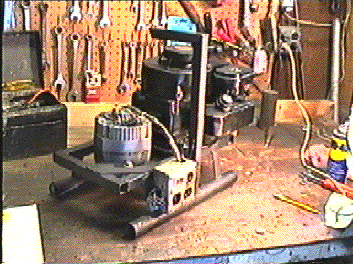|
|
![]()

![]()
|
|
![]()

![]()
Welcome! For some ethereal reason, I have a genuine interest and fascination with generators and electricity. I'm sure it all started many years ago when I was 4 years old and was playing in the basement of our house. Little did I know, I was about to get my first electric shock. I reached over to move a large electric fan, that had a short in it and was hot with 120 volts of good 'ol Alternating Current. Well, it took me quite a while to let go of that fan and after I did I went screaming to Mom. I had to be thinking, "What in the world happened and why did that hurt? What mysterous force did that?" After that experience, I was hooked on electricity.
My Uncle Norm (Mom's brother) did nothing to dispel that fascination! He would bring me boxes of electronic/electrical/mechanical "treasures", books and other things that furthered my interest. A lot of fascinating stuff for a curious kid like me. Geesh, I learned a lot of things from him! He is a superb machinist and craftsman of the first order.
Because of all the above reasons, I've built, designed and played with various forms of "Rotating Electrical Machinery" throughout my lifetime.
I'm not sure if it has reached the obsesion level yet... I still have a job so maybe I'm OK...?
(In building the more critical components of these generators, I have to give credit to Dewey King, NJ8V, a master machinist. He helped me with the machining and design of many of the parts, adaptors, couplings and other things too numerous to mention. If he ever decides to call in my debts to him, I'll be out at least an arm, a leg and my firstborn...)
One of the neatest ones that I built was this Delco Automobile Alternator (3 phase) that I converted to a single phase alternator. Voltage is regulated by a homebrewed regulator. The generator/engine combination is mounted on a small welded steel frame and powered by a typical lawnmower-type Briggs and Stratton Classic 3.5 hp engine.
It is capable of 700 watts at 120 Volts AC or DC output. The AC frequency is about 250 to 400 hz, depending of engine speed. You may ask, "What can you power at that frequency?" Plenty! Lightbulbs don't care what frequency they operate at. Devices that are power-transformer operated, such as a radio, TV, VCR, etc. work very well on this frequency.
I included a full wave diode bridge to also provide 120 Volts DC. This makes it possible to operate any universal-motor operated device. Power saws, drills, angle grinders, etc.
This generator is a veteran of a ham radio expedition to Manchester islands on the Ohio River. There it powered a TS-520 ham transceiver at about 350 watts maximum for the day. I'd refuel it about every hour or so. This power source has seen a lot of use and is very reliable.
You ask, "How in the world did you convert a 3 phase alternator to a single phase system?" In its original condition, it had 42 poles on the stator. The rotating field has 14 poles. (42 stator poles divided by 14 rotor field poles equals 3 phases,... Hey! How 'bout that? ) Well, NJ8V helped me cut out every third pole on the stator of the alternator. This left 2 poles with a large space between them and the next 2 poles. I wound each of the 2 pole pieces as a single pole, for a total of 14 poles.
In this close-up shot, notice the two pole faces wound as one and where each third pole has been cut out. A small coil form was made out of plexiglass to wind the coils. I used epoxy glue to hold the coils in place, with fiber tape as an insulator. The coils are about 36 turns of #18 wire, all connected in series.
The only advantage of converting the alternator to single phase was that I could get the full 120 vac out of the windings. That was better than having to use a transformer or other method of getting 120 volts out of it. Besides, it was a good education!
Here is a new welder/generator that I've just finished in February, 2000. It is a 100 ampere DC welder, powered by a B&S 8 hp gasoline engine. Click on it to go directly to this welder page.
Click here to see some of my other generators
Chrysler, Navy Surplus, Dayton, Kohler, Induction Generator, Renewable Energy Experiments, Dayton '99.
Other cool lightplant/generator links:
Georges Magnets-experiments and supplies
Also check out: Other Power.
Excellent site! He's a true man of many
talents!
Dan's Handmade Electricity page
Dan has some great ideas on making low rpm generators using Neodymium magnets. Included is experiments and results with pictures!
Email me at: [email protected]